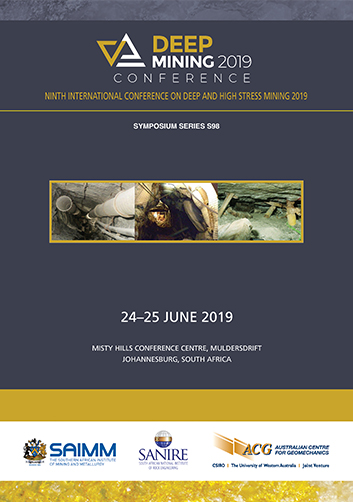Addressing some misconceptions regarding seismic hazard assessment in mines

|
Authors: Wesseloo, J |
DOI https://doi.org/10.36487/ACG_rep/1952_21_Wesseloo
Cite As:
Wesseloo, J 2019, 'Addressing some misconceptions regarding seismic hazard assessment in mines', in W Joughin (ed.), Deep Mining 2019: Proceedings of the Ninth International Conference on Deep and High Stress Mining, The Southern African Institute of Mining and Metallurgy, Johannesburg, pp. 267-292, https://doi.org/10.36487/ACG_rep/1952_21_Wesseloo
Abstract:
Seismic hazard assessment, in some form or another, has formed part of seismic risk management in seismically active hard rock mines for decades. Whilst recent advances have been made in seismic hazard assessment, some misconceptions with respect to seismic hazard assessment appear to be present in the industry. Where these misconceptions exist, they adversely affect the quality of seismic hazard assessment and risk management decision-making. This paper address some of these misconceptions the author has encountered in the mining industry.
References:
Boore, D. (1986). The Effect of Finite Bandwidth on Seismic Scaling Relationships. In Earthquake Source Mechanics. Das, S., Boatwright, J. and Scholz, C.H. (eds.), American Geophysical Union, Washington.
Di Bona, M. and Rovelli, A. (1988). Effects of the Bandwidth Limitation of Stress Drops Estimated from Integrals of the Ground Motion. Bulletin of the Seismological Society of America, 78 (5), 1818-1825.
Financial Times. Financial Times Lexicon [Online]. Financial Times. Available: [Accessed 22 March 2019 2019].
Gibowicz, S.J. and Kijko, A. (1994). An Introduction to Mining Seismology, San Diego, Academic Press.
Gutenberg, B. and Richter, C.F. (1944). Frequency of Earthquakes in California. Bulletin of the Seismological Society of America, 34 (4), 185-188.
Hudyma, M. and Potvin, Y. (2004). Seismic Hazard in Western Australian Mines. The Journal of The South African Institute of Mining and Metallurgy, 104 (5), 265-275.
Hudyma, M.R. (2008). Analysis and Interpretation of Clusters of Seismic Events in Mines. PhD Thesis, University of Western Australia.
Jonkman, S.N., van Gelder, P.H.A.J.M. and Vrijling, J.K. (2003). An Overview of Quantitative Risk Measures for Loss of Life and Economic Damage. Journal of Hazardous Materials, 99 (1), 1-30.
Kijko, A. (2004). Estimation of the Maximum Earthquake Magnitude, Mmax. Pure and Applied Geophysics, 161 (8), 1655-1681.
Kijko, A. (2012). On Bayesian Procedure for Maximum Earthquake Magnitude Estimation. Research in Geophysics, 2 (1).
Kijko, A. and Funk, C. (1994). The Assessment of Seismic Hazards in Mines. The Journal of the South African Institute of Mining and Metallurgy, 94 (4), 179-185.
Kijko, A. and Singh, M. (2011). Statistical Tools for Maximum Possible Earthquake Magnitude Estimation. Acta Geophysica, 59 (4), 674-700.
Lasocki, S. and Urban, P. (2011). Bias, Variance and Computational Properties of Kijko's Estimators of the Upper Limit of Magnitude Distribution, M-Max. Acta Geophysica, 59 (4), 659-673.
Mendecki, A. (2012). Keynote Lecture: Size Distribution of Seismic Events in Mines. Proceedings of Australian Earthquake Engineering Society Conference. Australian Earthquake Engineering Society, pp. 20.
Mendecki, A.J. (2013). Frequency Range, Log E, Log P and Magnitude. Proceedings of Eighth International Symposium on Rockbursts and Seismicity in Mines - RaSiM8. Malovichko, A. and Malovichko, D., (eds.), Russia, Geophysical Survey of Russian Academy of Sciences, Mining Institute of Ural Branch of Russian Academy of Sciences, pp. 167-180.
Mining Research Directorate (1996). Canadian Rockburst Research Program 1990-1995, a Comprehensive Summary of Five Years of Collaborative Research on Rockbursting in Hardrock Mines, Canada, CAMIRO Mining Division.
Morkel, I.G. and Wesseloo, J. (2017). The Effect of Sensor Bandwidth Limitations on the Calculation of Seismic Hazard for Mines. Proceedings of Ninth International Symposium on Rocbursts and Seismicity in Mines. Vallejos, J.A., (ed.), Ediarte S.A., pp. 42-49.
Page, R. (1968). Aftershocks and Microaftershocks of the Great Alaska Earthquake of 1964. Bulletin of the Seismological Society of America, 58 (3), 1131-1168.
Potvin, Y., Wesseloo, J., Morkel, I.G., Tierney, S.R., Woodward, K. and Cuello, D. (2019). Management of Seismic Risks in Metalliferous Mines. Proceedings of The Ninth International Conference on Deep and High Stress Mining - Deep Mining 2019. The Southern African Institute of Mining and Metallurgy, pp. in print.
Stacey, T.R., Terbrugge, P.J. and Wesseloo, J. (2007). Risk as a Rock Engineering Design Criterion. Challenges in Deep and High Stress Mining. Potvin, Y., Stacey, T.R. and Hadjigeorgiou, J. (eds.), Australia, Australian Centre for Geomechanics.
Terbrugge, P.J., Wesseloo, J., Venter, J. and Steffen, O.K.H. (2006). A Risk Consequence Approach to Open Pit Slope Design. Journal of the South African Institute of Mining and Metallurgy, 106 (7), 503-511.
Utsu, T. (1999). Representation and Analysis of the Earthquake Size Distribution: A Historical Review and Some New Approaches. Pure and Applied Geophysics, 155 (2-4), 509-535.
Wesseloo, J. (2018). The Spatial Assessment of the Current Seismic Hazard State for Hard Rock Underground Mines. Rock Mechanics and Rock Engineering, 51 (6), 1839–1862.
Wesseloo, J. and Read, J. (2009). Acceptance Criteria. Guidelines for Open Pit Slope Design. Stacey, P. and Read, J. (eds.), Australia, CSIRO Publishing.
© Copyright 2026, Australian Centre for Geomechanics (ACG), The University of Western Australia. All rights reserved.
View copyright/legal information
Please direct any queries or error reports to repository-acg@uwa.edu.au
View copyright/legal information
Please direct any queries or error reports to repository-acg@uwa.edu.au